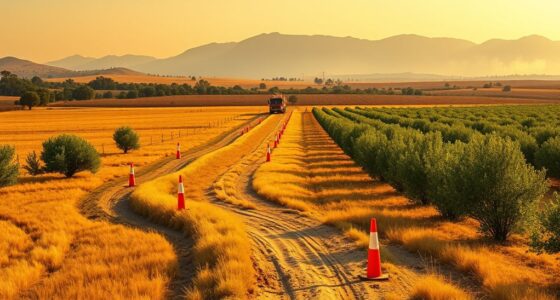Tenant farming is a system where landowners and farmers collaborate to grow crops on rented land. Historically, it developed in the U.S. after the Civil War, providing a way for freed slaves and others to work the land, albeit often leading to cycles of debt. While practices vary regionally, tenant farmers face unique challenges, including legal protections and social status. If you're curious about how tenant farming has evolved and its current forms, there's much more to explore.
Key Takeaways
- Tenant farming involves landowners renting land to farmers, who provide labor and possibly additional resources in return for a share of the crops or cash payments.
- Historically, tenant farming gained prominence in the U.S. post-Civil War, particularly among freed slaves and impoverished white farmers in the South.
- The system often trapped farmers in cycles of debt due to high operational costs and fluctuating crop prices, limiting their economic stability.
- Regional variations exist, with differing practices and tenant protections affecting the social and economic dynamics of farming communities.
- Legal frameworks and community advocacy play critical roles in shaping tenant rights and improving conditions for farmers in various regions.
Definition and Structure of Tenant Farming
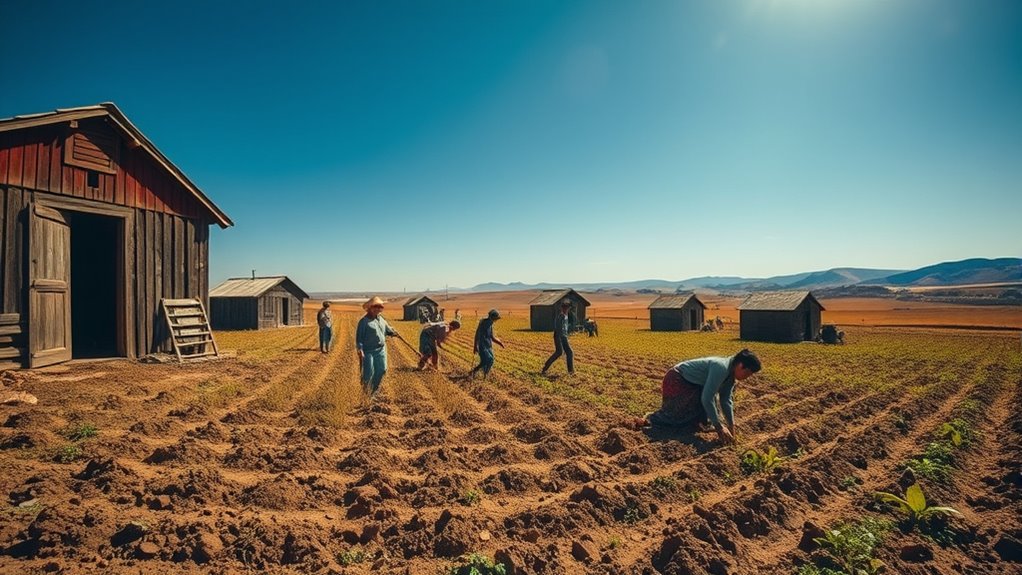
Tenant farming is a system where landowners and farmers collaborate to cultivate crops on rented land. In this arrangement, landowners provide the land and often supply operating capital and management support.
As a tenant farmer, you contribute labor and may invest additional resources. Payment methods vary; you might pay rent through a share of the crop, cash, or a mix of both.
There are different types of tenant farming arrangements, including sharecropping, fixed rent, and share tenancy, each with unique terms.
Legal frameworks may protect your rights, ensuring security of tenure and eviction protections. Understanding these structures helps you navigate the complexities of tenant farming and identify the best arrangement for your needs.
Historical Context in the United States
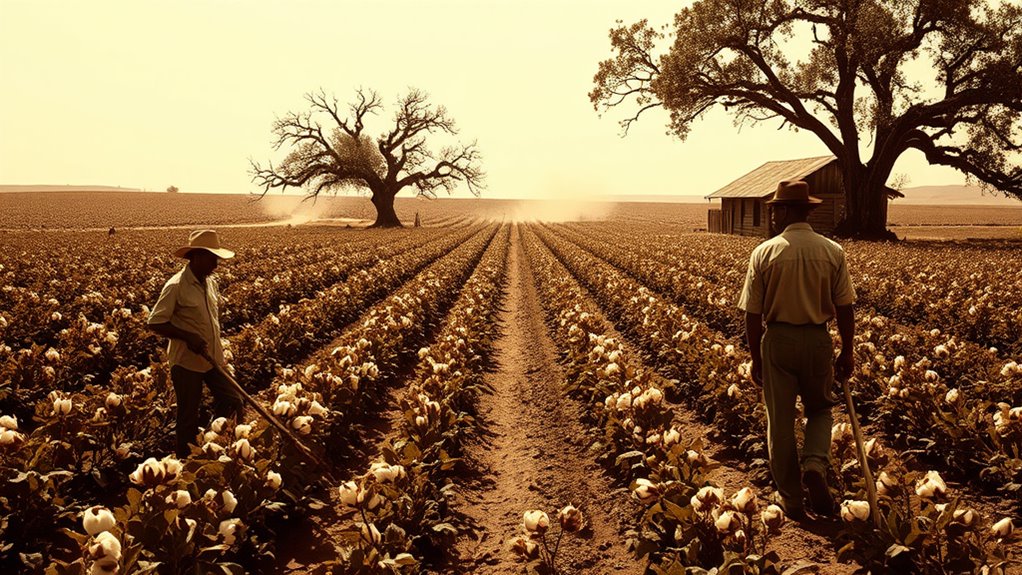
The historical context of tenant farming in the United States reveals a complex interplay of social and economic factors, particularly after the Civil War. Many freed slaves and white farmers turned to tenant farming due to a lack of capital for land ownership.
In the South, especially the Black Belt, African-American tenant farmers worked under white landowners, while in the North, tenant farming was viewed as a step toward land ownership.
Though it provided some stability through housing and care, the system often trapped farmers in debt cycles.
Economic Impact of Tenant Farming

While tenant farming offers a pathway for those unable to purchase land, it often comes with significant economic implications that can hinder long-term prosperity.
You may find that landowners provide the land and sometimes the capital, while you contribute labor and resources. However, the financial landscape can be challenging. High operational costs and crop price fluctuations often lead to debt accumulation, trapping you in cycles of poverty.
With limited cash flow, investing in necessary farming inputs becomes difficult. Additionally, the pressure to focus on cash crops results in soil depletion and limits crop diversity.
Ultimately, these factors can compromise both your economic stability and the long-term sustainability of agricultural practices in your community.
Regional Variations in Tenant Farming Practices

Across different regions, tenant farming practices vary significantly, shaped by local economic conditions, cultural norms, and historical contexts.
In the United States, for instance, tenants often bring their own tools and animals, setting it apart from sharecropping. Meanwhile, in the United Kingdom, government regulations protect tenant rights, promoting stability.
In the U.S., tenant farmers provide their own tools, contrasting with the UK's strong tenant protections that ensure stability.
Japan's post-WWII reforms eliminated absentee landlordism, allowing tenants to purchase land, while Canada has seen tenant farming practiced by immigrants since the 19th century.
Conversely, countries like Thailand and Denmark report low percentages of tenant farmers, with most owning their land.
These regional differences reflect diverse agricultural practices and historical developments, influencing how tenant farming evolves worldwide.
Legal and Social Aspects of Tenant Farming

Regional variations in tenant farming practices highlight how legal and social factors come into play in shaping these arrangements.
You'll find that lease requirements, such as detailed contracts and state-specific laws, protect tenant rights, including post-lease crop harvesting. However, these laws vary widely, affecting your obligations and security.
Socially, tenant farming can create dependency cycles, often leading to poverty and inequality, particularly in regions with historical challenges. As a tenant, you might also face inferior social status compared to landowners, limiting your bargaining power.
Yet, communities often rally around tenant farmers, advocating for better conditions and rights. Understanding these legal and social dynamics is crucial for navigating the complexities of tenant farming today.
Evolution and Decline of Tenant Farming
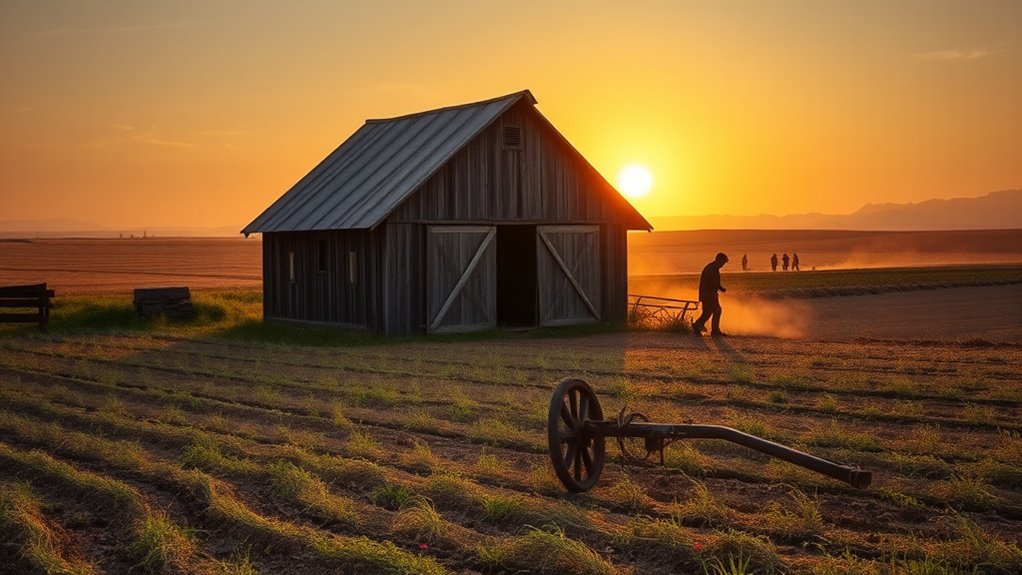
As tenant farming evolved, it transformed from a flexible labor arrangement before the Civil War into a dominant system for organizing labor in the South, especially after the abolition of slavery.
Initially, mostly white tenants worked the land, but postbellum, many formerly enslaved individuals became tenant farmers. Economic pressures, like declining cotton prices, increased tenants' dependency on landlords and contributed to cycles of poverty.
Soil degradation from cash crop focus further strained their financial stability. The Great Depression underscored the need for reform, but early New Deal programs often overlooked tenant issues.
Many tenants frequently moved, seeking better conditions, which weakened their ties to the land. These factors, combined with unfavorable agricultural policies, marked the decline of tenant farming.
Contemporary Forms of Tenant Farming
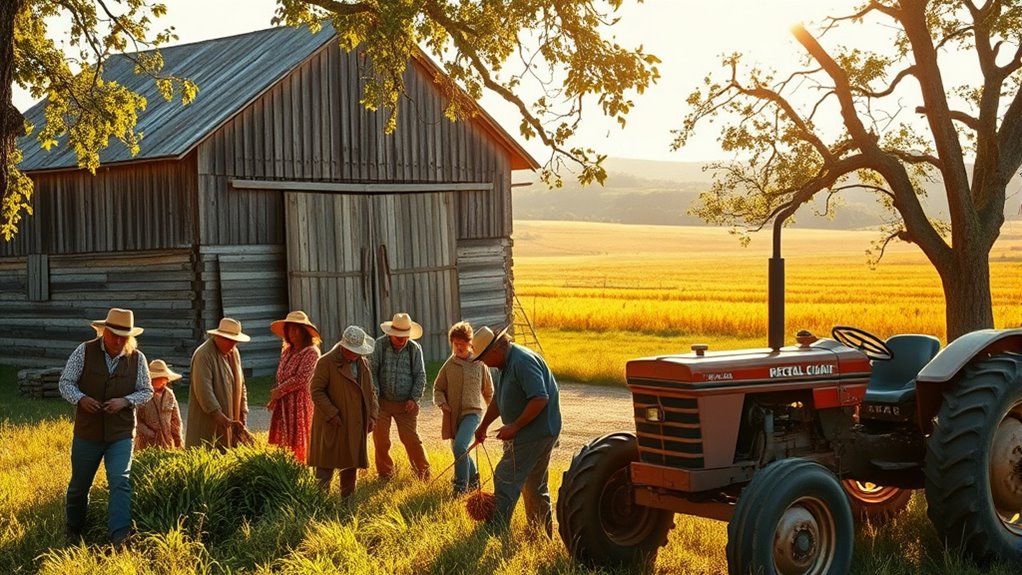
The decline of traditional tenant farming has paved the way for contemporary forms that adapt to modern economic and legal landscapes.
Today, legal frameworks protect tenants' rights, ensuring fair rent limitations and lease terms. You'll notice that corporate entities often dominate the scene, enabling larger operations through legal and tax advantages.
Legal protections for tenants now ensure fair rent and lease terms, while corporate dominance facilitates larger farming operations through strategic advantages.
Advanced technology, like precision farming and data management systems, boosts efficiency and sustainability. Various arrangements exist, from cash rent contracts to sharecropping variants, offering flexibility in how you manage your farming operations.
Cooperative models are also gaining traction, allowing small farmers to pool resources and negotiate better deals.
Frequently Asked Questions
How Do Tenant Farmers Differ From Hired Laborers?
Tenant farmers differ from hired laborers in several key ways.
You don't own the land as a tenant farmer, but you might own your tools and equipment. Instead of hourly wages, you pay rent in cash or a share of crops. You have more autonomy in farming decisions and share crop risks with landowners.
In contrast, hired laborers typically enjoy more stable income but have less control and commitment in their work.
What Crops Are Most Commonly Associated With Tenant Farming?
When you think about tenant farming, you'll find that certain crops are most commonly associated with it.
In the South, cotton often takes the lead as a primary cash crop. You'll also see corn thriving in the Corn Belt and soybeans flourishing in places like Arkansas.
Additionally, rice is significant in Arkansas, while wheat and other grains are cultivated in various regions.
These crops play crucial roles in the tenant farming system you might encounter.
Are There Modern Examples of Tenant Farming Outside the U.S.?
Yes, there are modern examples of tenant farming outside the U.S. In Ethiopia, for instance, medium-scale tenant farmers cultivate about 60% of the irrigated land, focusing on crops like tomatoes and onions.
Japan also showcases tenant farming, particularly after post-WWII reforms that transformed land ownership.
In the UK, tenant farming is efficient and regulated, ensuring tenant rights are protected.
These examples highlight how tenant farming continues to thrive globally today.
What Challenges Do Tenant Farmers Face Today?
Did you know that nearly 30% of U.S. farms are operated by tenant farmers?
Today, you face several challenges, such as high rents consuming significant portions of your income and low commodity prices squeezing your profits.
Rising input costs for seeds and fertilizers add extra strain, while increasing interest rates on loans make financing difficult.
Navigating these obstacles requires savvy market awareness and strategic planning to ensure your farming operation remains viable.
How Does Tenant Farming Affect Local Communities?
Tenant farming affects local communities in various ways.
You might notice economic dependency emerging, as tenants rely on landlords for stability, often leading to cycles of debt when crop prices fluctuate.
Social dynamics also shift, perpetuating inequality and limiting mobility.
Additionally, environmental issues arise from unsustainable practices, impacting soil health and ecosystems.
Local businesses can suffer too, as tenants struggle with cash flow, hindering overall economic growth and community resilience.
Conclusion
In conclusion, tenant farming shaped agricultural practices and lives across the globe, leaving an indelible mark on history. While it's evolved over time, its legacy continues to influence modern farming dynamics. You might say tenant farming was the backbone of rural economies, fueling countless communities. As you explore contemporary forms of this age-old practice, you'll see how it adapts to new challenges while still echoing its rich, complex past. The story of tenant farming is far from over!






